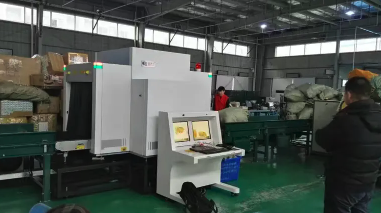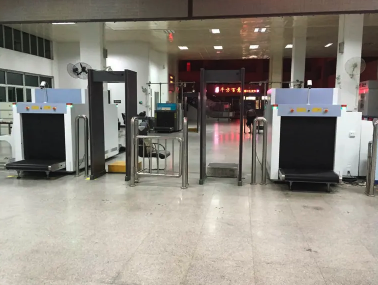Views: 9 Author: Site Editor Publish Time: 2025-07-30 Origin: Site








Airport scanners are an essential part of modern travel. They play a crucial role in ensuring the safety and security of passengers and staff. But what exactly do these scanners check for, and how do they work? In this article, we’ll dive deep into the world of airport scanners, exploring their functions, the latest technologies, and how companies like Safeway Inspection System Limited are leading the way in this field.
Airport scanners are designed to detect a wide range of items that could pose a threat to air travel. These include:
Explosives: Both commercial and military-grade explosives.
Liquids: Liquid explosives, flammable liquids, and corrosive substances.
High-Density Materials: Items that could be used to conceal weapons or other dangerous objects.
Metal Objects: Weapons, knives, and other metallic items that could be used in an attack.
Concealed Items: Items hidden in luggage or on the person that might not be immediately visible.
| Item Type | Description |
|---|---|
| Explosives | Both commercial and military-grade explosives. |
| Liquids | Liquid explosives, flammable liquids, and corrosive substances. |
| High-Density Materials | Items that could be used to conceal weapons or other dangerous objects. |
| Metal Objects | Weapons, knives, and other metallic items that could be used in an attack. |
| Concealed Items | Items hidden in luggage or on the person that might not be immediately visible. |

Airport scanners are sophisticated devices designed to detect a wide range of items that could pose a threat to air travel. These scanners use various technologies to ensure that nothing dangerous slips through. Let’s take a closer look at some of the most common methods used in airport scanners.
X-ray scanners are the most familiar type of airport scanner. They use X-ray radiation to create detailed images of the contents of luggage. When X-rays pass through a bag, they interact with the materials inside, creating a shadow-like image that reveals the shape and density of the items. Different materials absorb X-rays differently, so denser items like metals show up more prominently than lighter materials like clothing. This helps security personnel quickly identify potential threats, such as weapons or explosives, hidden within the luggage.
X-Ray Emission: The scanner emits X-rays that pass through the luggage.
Image Capture: The X-rays that pass through the bag are captured by a detector on the other side.
Image Processing: The detector converts the X-ray data into a digital image, which is then displayed on a screen for security personnel to review.
Density Analysis: The image shows different shades of gray, representing the varying densities of the items inside the bag. Denser materials appear lighter, while less dense materials appear darker.
Explosives trace detectors (ETDs) are specialized devices designed to detect minute traces of explosives. These detectors are incredibly sensitive and can identify even the smallest amounts of explosive materials. They work by analyzing the air around luggage or by swiping surfaces to collect samples. If explosives are present, the detector will alert security personnel.
Sample Collection: Security personnel use a swab to collect samples from the surface of luggage or other items.
Air Sampling: Some detectors analyze the air around the luggage to detect volatile compounds released by explosives.
Chemical Analysis: The collected samples are analyzed using chemical sensors that can identify specific explosive compounds.
Alert System: If the detector identifies any explosive materials, it triggers an alarm to alert security personnel.
Infrared scanners use infrared light to detect hidden items. This technology can penetrate certain materials and reveal objects that might not be visible to the naked eye. Infrared scanners are particularly useful for detecting items that might be concealed within other objects or behind layers of material.
Infrared Emission: The scanner emits infrared light, which is invisible to the human eye.
Reflection and Absorption: The infrared light reflects off or is absorbed by the items inside the luggage.
Image Capture: The scanner captures the reflected infrared light and converts it into an image.
Thermal Imaging: The resulting image can show temperature differences and material properties, helping to identify hidden items.
Metal detectors are used to identify metallic objects. They work by emitting a magnetic field and detecting any changes caused by metal objects. These detectors are commonly used at airport checkpoints to scan passengers and their carry-on items. Metal detectors are particularly effective at identifying weapons, knives, and other metallic items that could pose a threat.
Magnetic Field Emission: The detector emits a low-frequency magnetic field.
Field Distortion: When a metal object passes through the magnetic field, it distorts the field.
Detection and Alert: The detector senses the distortion and triggers an alarm to alert security personnel.
As technology advances, so do the capabilities of airport scanners. Companies like Safeway Inspection System Limited are at the forefront of this innovation. They integrate intelligent software and big data to enhance the effectiveness of their scanners. These advancements are crucial for improving security, efficiency, and overall passenger experience. Let’s delve deeper into some key features that make these technologies stand out.
Safeway’s integrated management platform is a game-changer in the world of airport security. This platform allows operators to monitor performance metrics in real-time, providing a continuous stream of data that helps security personnel make faster and more informed decisions. Real-time monitoring is essential for several reasons:
Immediate Threat Detection: Security teams can respond to potential threats as soon as they are detected, minimizing the risk of incidents.
Efficient Resource Allocation: By having real-time data, operators can allocate resources more effectively, ensuring that high-risk areas receive the necessary attention.
Enhanced Decision-Making: Real-time analytics provide security personnel with the information they need to make quick and accurate decisions, reducing the likelihood of false alarms and improving overall security.
One of the most significant advancements in airport scanner technology is the development of advanced algorithms for automatic image analysis. These algorithms can automatically detect a wide range of potentially dangerous items, including explosives, liquids, and high-density materials. This technology is crucial for several reasons:
Reduced Manual Inspection: By automating the detection process, security personnel can focus on more complex and high-risk situations, reducing the need for manual inspection and speeding up the screening process.
Improved Accuracy: Advanced algorithms can detect subtle differences in material density and composition that might be missed by the human eye, improving the overall accuracy of the scanning process.
Consistency: Automated systems provide consistent results, ensuring that the same level of scrutiny is applied to every scan, regardless of the time of day or the experience of the operator.
Centralized data management is another critical feature of modern airport scanners. All image data from X-ray terminals is connected to a central server, allowing for optimized distribution of scanned images among different X-ray stations. This centralized approach offers several key benefits:
Enhanced Collaboration: Security teams can easily share and review data, ensuring that everyone has access to the most up-to-date information.
Improved Efficiency: Centralized data management allows for the efficient distribution of scanned images, reducing bottlenecks and improving the overall flow of the screening process.
Data Integrity: By storing all data in a central location, security teams can ensure the integrity and security of their data, reducing the risk of data loss or tampering.
Analytics and Reporting: Centralized data management enables advanced analytics and reporting capabilities, allowing security teams to identify trends and patterns that might indicate potential threats.
Big data and artificial intelligence (AI) play a crucial role in enhancing the capabilities of airport scanners. By analyzing vast amounts of data, AI algorithms can identify patterns and anomalies that might indicate potential threats. This technology is essential for several reasons:
Predictive Analytics: AI can predict potential threats based on historical data, allowing security teams to take proactive measures.
Enhanced Detection: AI algorithms can detect subtle differences in material density and composition, improving the overall accuracy of the scanning process.
Automated Decision-Making: AI can automate many aspects of the decision-making process, reducing the need for human intervention and improving overall efficiency.

The future of airport scanners is bright, with continuous advancements in technology. Here are some trends to watch:
Blockchain technology can provide a secure and transparent record of all scans, ensuring that data cannot be tampered with. The Internet of Things (IoT) will connect devices, allowing for real-time monitoring and analysis.
Collaboration between governments and private companies will be crucial in developing and implementing advanced security solutions. Public-private partnerships can leverage the expertise and resources of both sectors to enhance security.
Security threats do not respect borders, so international cooperation is essential. Countries will need to work together to share information and best practices, ensuring that global travel remains safe and secure.
The most common items detected include explosives, liquids, high-density materials, and metal objects.
X-ray scanners use radiation to create images of the contents of luggage, revealing the shape and density of items inside.
Big data helps security personnel make faster and more informed decisions by analyzing real-time performance metrics.
Safeway provides advanced scanners and integrated management platforms that enhance the effectiveness of security inspections.
Future trends include the increased use of AI and machine learning, blockchain and IoT integration, and greater international cooperation.
Airport scanners are a vital component of modern security measures. They protect passengers, staff, and infrastructure from a wide range of threats. Companies like Safeway Inspection System Limited are driving innovation in this field, integrating advanced technologies to enhance security and efficiency. As we look to the future, the continued development of these technologies will be crucial in keeping our skies safe.
0086 13670213490